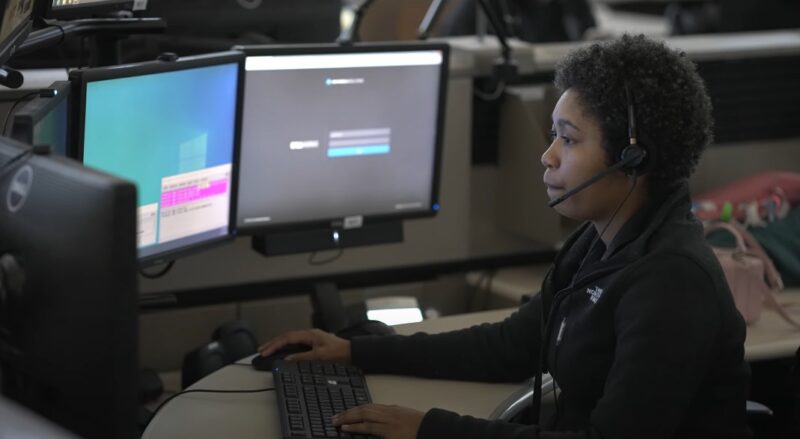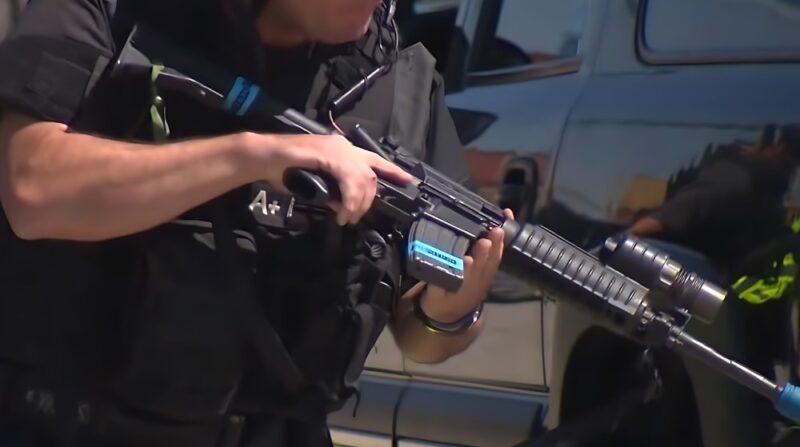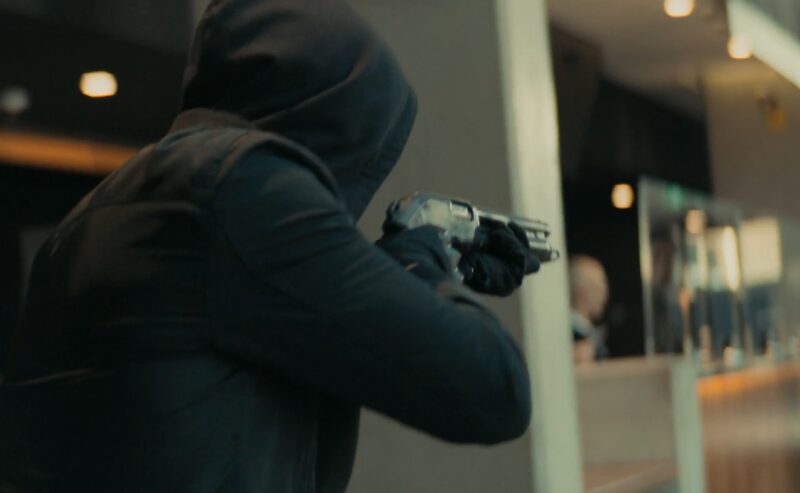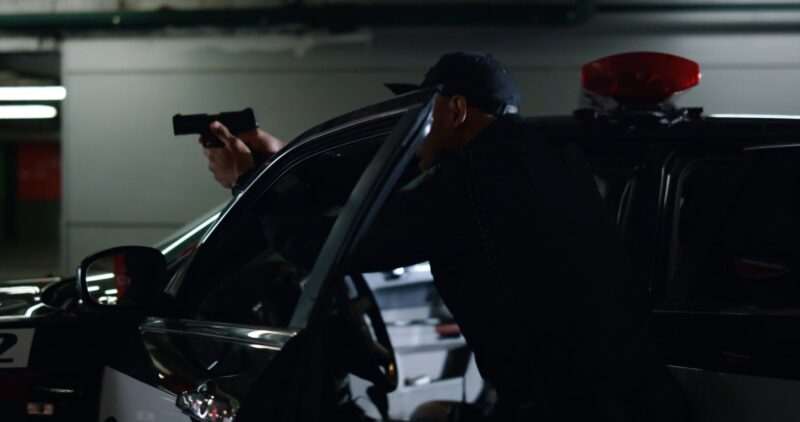February 28, 1997, was a day of mayhem and miracles in North Hollywood. A pair of gunmen, clad in ski masks and full body armor, swaggered into the Bank of America shortly after it opened for business, spray-painted the lobby with bullets from AK-47 and M-16 assault rifles, and launched what was to become one of the most prolonged and shocking gun battles in the history of the Los Angeles Police Department. The 40-minute firefight, much of which aired live on television, gripped the nation with its powerful images of heroism and horror.
Sergeant Dean Haynes, of the LAPD North Hollywood Division, was one of the first supervisors on scene. As three civilians ran up to him to offer suspect descriptions, Haynes recognized the staccato sound of automatic weapons fire coming from the bank, and ordered everyone to get down behind his police vehicle. “I watched over the hood,” he said, “as the suspects came walking out of the bank, dragging their money bag.” Setting the loot next to their car, Haynes recalled a vivid, chilling moment when “the dye pack went off and red smoke came billowing out of the bag, and this guy walked around the parking lot shooting at everybody. Then he turned toward my car…”
Haynes’s 15-shot, 9-millimeter handgun paled in the shadow of the suspect’s military-style assault rifle, with its 100 round magazine, but he added wryly, “I aimed my mighty Barretta at him and he just lit up my car. The whole car rocked. The tires were popping and glass and metal went flying. I felt an object go into my shoulder, and I saw that the three citizens were injured from rounds going through the car or skipping up off the ground.”
LAPD Officer John Goodman, positioned across the street behind a van, found himself staring down the barrel of the suspect’s AK-47. “The van just started to explode,” said Goodman. “Glass was everywhere. Bullets skipped by.” Officers Stuart Guy and Jim Zboravan, along with detectives Tracy Angeles and William Krulac, returned fire, hoping to divert attention. The suspect “turned and started shooting at them,” Goodman said during an emotional news conference, “and I saw all four of them get shot. I got up and started running towards a mini-van, and (the suspect) turned and started shooting at me again. One of my rounds hit him, but it didn’t affect him. It was like throwing a rock at a wall.”
Haynes reassured the injured civilians that help was on the way as the suspect “sprayed my car a second time. I rose up to fire at him and saw that he was reloading. I also saw that he was covered with body armor.” Haynes sprinted to a tree for better cover, but was struck again. Despite his injuries, he returned fire and “put the information out over the radio to let everyone know that the suspects were using armor-piercing ammunition.”
“I kept telling him to stand by, someone’s coming. And he would say thank-you on the air. Terminology was out the door. I just kept talking to him to make sure he was alive.”
Communications

In the LAPD Communications Division, four floors below City Hall East in downtown Los Angeles, Police Service Representative (PSR) Johanna Ramirez was working the North Hollywood Division frequency as a Radio Telephone Operator (RTO). Officers Loren Farrell and Martin Perello, who were on routine patrol, happened to observe the armor-clad, weapons-toting suspects hauling a witness into the bank with them. Ramirez took their call. “Right away they set up a perimeter,” Ramirez recounted. “When the suspects started coming out of the bank, I thought, okay, we’re going into pursuit right now. I like pursuits, and I was ready to go.”
But there was no pursuit. As 9-1-1 calls poured in from citizens reporting the incident and radio traffic intensified with police units responding, PSR involvement escalated. Tonja Bellard, a 7-year veteran PSR who was nearly eight-months pregnant at the time, moved from the 9-1-1 board to help Ramirez with the radio. “When something big happens,” explained Bellard, “it’s normal for us to help each other out. It was getting so involved that we didn’t have time to bother with the computer. We both started writing notes and I ended up doing all the talking.”
Ramirez was stunned by the brutal tenacity of the suspects, who pumped more than 1100 rounds into citizens, officers, animals, buildings, automobiles, and anything else that happened to be in the line of fire. “As many officers as we got out there from other bureaus, it seemed like it wasn’t enough,” she said. “There were requests for help from everywhere.”
“It was very scary,” Bellard added, “but I just went into my job mode, doing what I’ve been trained to do. We have guidelines, but there are times when they are only that: guidelines. You have to use your instincts. I knew that I had to be clear enough for everyone in the field to understand me, and that I couldn’t let them know that I was stressed.”
Guadalupe De La Cruz, a trainee with only eight months experience, was relieving an RTO who had taken a meal break. Just as she plugged in, one of her units, “9L89” reported that he was en route to the bank. “9L89 is a one-man unit,” De La Cruz explained. “It was just seconds later that he came in yelling, ‘Live shots fired!’ And I could hear the shots in the background. So I immediately put out the information that he gave me, and after that, he started screaming for help, because he had been hit.”
Veteran PSR Robyn Frazier, who was sitting next to De La Cruz, offered support and guidance. “Usually there’s immediate closure to one of our help calls,” she said. “Our written procedures don’t go past the initial request for help other than assigning units to respond. But this situation just kept happening, and officers were down who hadn’t gotten any help.”
What Frazier and De La Cruz did not realize from their windowless vantage point fifteen miles from the scene was that the firefight was so intense and relentless it was impossible to mount rescue missions. According to Frazier, “One injured officer, Stuart Guy, just stopped broadcasting. He felt that he was going to be all right, since the suspects had moved past him, but because they kept spraying bullets, no one could approach him. When he stopped broadcasting, we almost forgot that he still needed someone to go to him.”
Although she continued to communicate the many rapid, sometimes garbled and confusing transmissions from the field, De La Cruz’s primary focus was on Officer Martin Whitfield, “9L89”, who was bleeding heavily and on the verge of losing consciousness. “I was really afraid,” she said. “I was praying, please don’t let him die. I am not going to be the last person he talks to.” For one fleeting moment, De La Cruz felt tears stinging her eyes and choking her voice. “He was crying and he was asking when are they coming,” she explained. “I kept telling him to stand by, someone’s coming. And he would say thank-you on the air. Police terminology was out the door. I just kept talking to him to make sure he was alive.”
For Officer Ed Guzman, the heavy radio traffic was a problem. Without faulting anyone, he expressed concern that in an incident where “everybody was responding”, too many transmissions were “unit responding” repeats, which blocked out critical information. And because so many reports poured in about the same wounded officers, “the dispatchers couldn’t tell how many officers had actually been hit.”
Deborah Clayton and Karen Koukal were working as Bureau Command Coordinators (BCC), coordinating rescue ambulances (RA) with the fire department and assistance from other agencies. “Every other broadcast was an officer down at some new location, shots are still being fired, we need SWAT, we need RAs, we need more units,” said Clayton. “One moment that sticks out in my mind was when one of the units in the field said he was taking 80-100 rounds.”
At one point, Robin Frazier started doing a roll call with one of the field lieutenants in an attempt to track everyone. “I just started shaking my head,” she recalled, “because there were several units that weren’t answering up. That’s when it hit me what type of situation this was. It was really shocking that so many officers had been shot, and civilians as well.” Pausing to reflect, she added, “I’ve been through the riots and the earthquake and the floods, but this was different. I kept waiting to hear ‘code four’ to let everyone know that everything was okay, but it never came.”
“I’ve been through the riots and the earthquake and the floods, but this was different. I kept waiting to hear ‘code four’ to let everyone know that everything was okay, but it never came.”
Command in the Urban Battlefield

“This was really an extraordinary situation from a couple of perspectives,” said San Fernando Valley Commander Royal Scott LeChasse, a 27-year LAPD veteran. “First, it wasn’t pre-planned. When we have the opportunity to pre-plan events, we can reserve tactical frequencies and make assignments of personnel. We configure either into squads or mobile field forces, give them unit designations, and reserve radio frequencies for them. But this was a spontaneous event, with units from virtually all over the city coming in.”
LeChasse’s first order of business was command and control. “I tried to do a little of that en route by using the radio,” he said, “but there was so much traffic on the North Hollywood frequency, I couldn’t get through. I tried the tactical frequency they were on to identify who the incident commander was, but there wasn’t one at the time.” The incident, which escalated at each turn, had drawn everyone into the fray, with no one trying to “pull all of the parts together.”
LeChasse almost got sucked into the action as well. “I stopped, put my vest on, and started to get involved in the tactical situation,” he said. “Then finally I said, wait a minute, we have hundreds of people running around here and there’s no incident commander.” A local furniture store “worked beautifully” as an improvised command post, with it’s dining room section abutting a row of television sets which crackled with live news broadcasts.
With so many self-initiated responses coming from divisions citywide, personnel accountability was a problem. “All these people were operating on different frequencies,” LeChasse explained. “It was exceedingly difficult to figure out who was where. What we ended up doing, for lack of a more sophisticated system, was to send runners around trying to identify everyone.”
LeChasse credited the incident command system for allowing multiple agencies, to coordinate operations quickly and effectively. “This incident was very intense,” he said. “I can never remember a firefight that lasted as long as this.”
Despite the many communications challenges, LeChasse was quick to laud the dispatch staff. “The RTOs performed exceedingly well,” he said. “It showed in their professionalism and in the manner in which they were able to remain calm and keep people calm on the other end of the radio.”
“It’s absolutely a miracle, when you consider the number of rounds fired, that the suspects were the only people killed.”
Aftermath: A Time For Healing And Recognition

Once the two obvious suspects had been killed, the incident still continued for several hours, compounded by reports that other involved individuals were hiding in the neighborhood. “I was on the radio for four straight hours,” said RTO Tonja Bellard. “And for three nights, I didn’t get any sleep. We were debriefed and all, but at night in my mind I was going back and forth over everything I had said.”
The PSRs who were most intensely involved in the incident experienced normal stress reactions, including replaying the mind-tape of the voices of wounded officers calling for help, with no one responding. Guadalupe De La Cruz, who was worried about Officer Martin Whitfield and the others who were injured, “cried all the way home. Everyone kept telling me that Martin was going to be okay, but it wasn’t real to me. I needed to see for myself.” The department arranged for Whitfield and De La Cruz to meet at the hospital. “He told everyone to ‘get that dispatcher in here’,” laughed De La Cruz, explaining that the personal meeting helped expedite recovery for both of them.
Three days after the incident, Lt. Nick Zingo, who had served as the incident commander, organized a recognition ceremony for the PSRs and arranged for them to meet the officers who had been on scene. “Too often we overlook the civilian employees in the department,” he said. “We wanted to let the PSRs know we were thankful for what they did.” With community support, including a fully-stocked limousine to transport the PSRs from the Communications Center to the North Hollywood Division, Tonja Bellard, Guadalupe De La Cruz, Robyn Frazier, Deborah Clayton, Johanna Ramirez and Karen Koukal were presented with plaques, flowers and angel pins as Lt. Zingo read a special poem comparing the PSRs to “guardian angels”.
Despite being off-duty to recover from their injuries, Officer James Zboravan and his wounded colleagues helped present the awards. Zboravan said, “I broke down when I was explaining how I felt about the RTOs. I was really grateful to them. It was wonderful to put a face and name to the voice. A lot of time officers take the RTOs for granted, but that’s something I’ll never do, because of this incident.”
For dispatchers and officers alike, meeting in person was a major step in their recovery. As Tonja Bellard explained, “This incident didn’t end for me until I met those officers and could touch and hug the actual people who had lived through this thing. After that I finally got to sleep again.”
A total of seven civilians and one dog were wounded. Eleven LAPD officers were injured, nine suffering gunshot wounds. Two of the eight damaged police vehicles were beyond repair. Sgt. Dean Haynes’s gun-blasted police car was donated to the LAPD Museum. “The rounds went right in one side and out the other,” he said, “but no rounds penetrated the engine block, which I’m here to testify to. It’s absolutely a miracle, when you consider the number of rounds fired, that the suspects were the only people killed.”
According to Cmdr. LeChasse, “One of the best things we did was ask a City Councilman to introduce a motion to cover all the damage claims as quickly as possible. We didn’t cause all the damage, but when you start making people whole again, paying for their cars, paying for the bullet holes in the side of the building, this means a lot to the community.” LAPD representatives and crisis counselors launched community outreach programs within a day after the incident. “Our goal was to get things back to normal as quickly as possible,” said LeChasse.
With such a high-profile event, media attention was immediate and at times overwhelming, adding both a positive glow to the aftermath, and the stress of being abruptly thrust into the spotlight. PSRs Tonja Bellard and Guadalupe De La Cruz were named “Person of the Week” by the ABC Evening News and interviewed by dozens of television news organizations and newspapers. With so many media requests coming in, the department finally put a moratorium on access to personnel who were involved in the incident.
“I never expected anything to come out of this,” said Bellard, who is currently on maternity leave to care for her new son. “We have emergencies every day. We handle them and we move on.” Honored by the outpouring of recognition, but wary of the spotlight, with its movie-of-the-week offers and other enticements, Bellard has remained philosophical: “Even though I was the person out front during this particular incident, my co-workers and supervisors were right there, too. We worked as a team. I hope that the recognition we’ve received is something that dispatchers everywhere will benefit from.”

